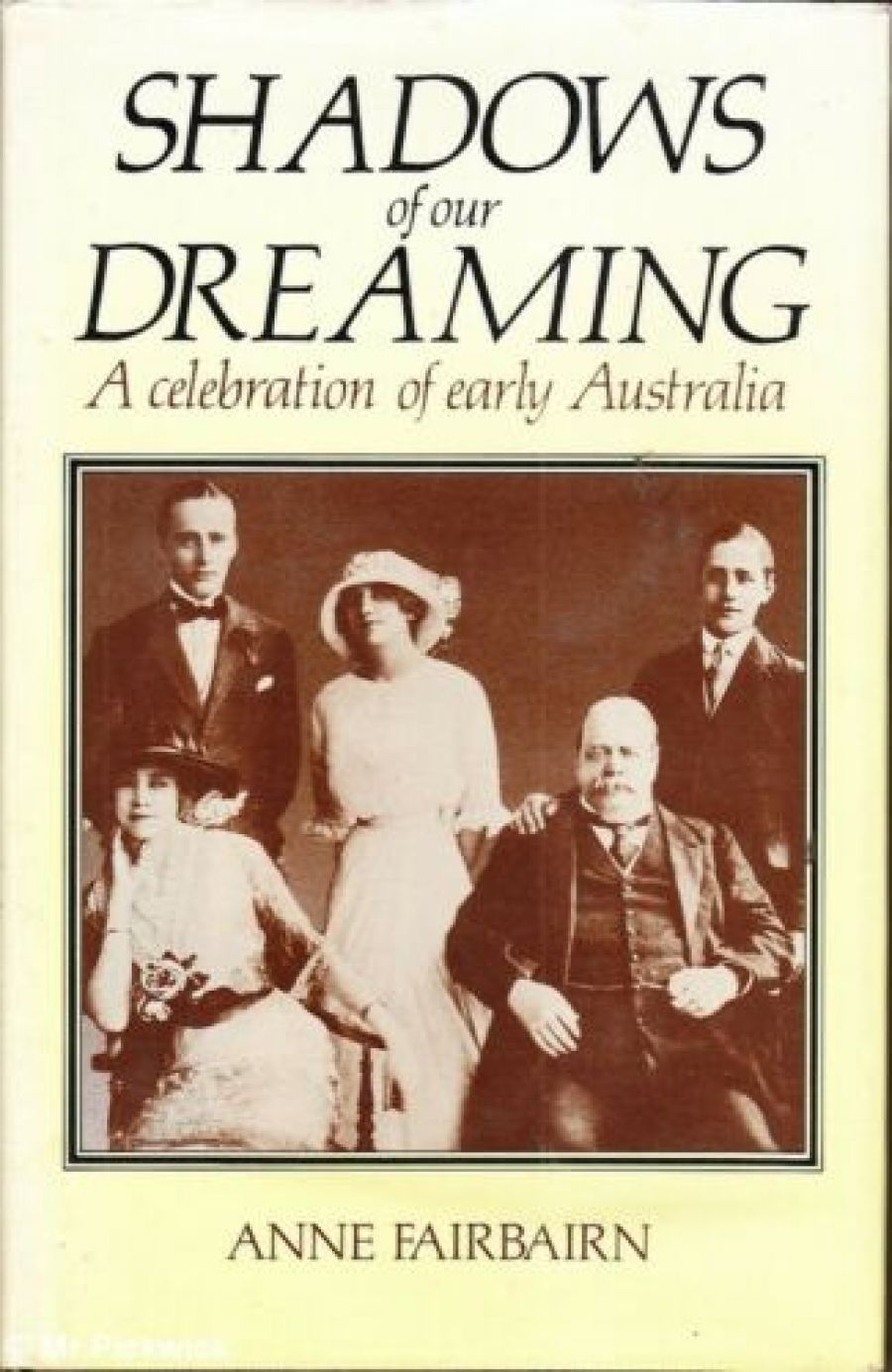
- Free Article: No
- Contents Category: Poetry
- Review Article: Yes
- Article Title: The land and its people
- Online Only: No
- Custom Highlight Text:
It is difficult for a reviewer to do justice to this enchanting book. But if one were looking for something to give to an Australian to help him better understand the history, traditions, literature, environment, and folklore of his country – or if one wished to help a visitor to Australia to an appreciation of all those circumstances from 1788 to the present day which have shaped the characters and characteristics of those who inhabit this vast continent, then this book is it.
- Book 1 Title: Shadows of Our Dreaming
- Book 1 Subtitle: A celebration of early Australia
- Book 1 Biblio: Angus & Robertson, illus., 250 pp, $14.95 pb
Each section represents a vignette of the Australian scene, reflecting the author's consciousness of it; and just as each poem records a single experience, so an accompanying illustration, with the same economy and grace of form, but deriving from Aboriginal symbolism, complements the poem.
The result is dramatic, even miraculous, in the understanding it creates. A.D. Hope's analysis of it, in his Preface, could not be bettered: ‘The pictures should not be looked at as illustrations to the poems, any more than the poems can be treated as explication of or comment on the pictures. They are meant to go together in another and more meaningful way. The pictures are drawn from the author's knowledge of Aboriginal works of art and Aboriginal symbolism, so that the sensibility of the original inhabitants of this country, their vision of the world, their customs and legends are brought into relation with the sensibility of the European; the language of one of the Europeans as a poet is set up against the visual imagery of the Aborigines. And not only does this give a sense of double and doubly enriched meaning to each of the elements; in a curious way the Aboriginal visual image with its abstractions of detail, its sense of looking both at and through the object depicted, links with the haiku poet's contemplation of an instant of experience and his indication of an inner, enduring meaning.’
Take for instance ‘Malparara’ (Aboriginal for ‘two friends’):
Silent companion
Diminishing and growing —
A swaggie’s shadow.
Anne Fairbairn then quotes Henry Lawson: ‘The Australian swag was born of no other land’ – and goes on to describe the role of the swaggie in earlier days: his habits and wanderings; the difference between a swaggie and a sundowner; the lore and literature that have grown up about him, leading inevitably to ‘Waltzin’ Matilda’.
She combines the past and present with skill and sensibility. Thus, ‘Wumba’ (‘morning star’): ‘With winking lights a 747 crosses / The pale morning star’, so to an Aboriginal song about the star, translated by Ronald Berndt: then a brief account of aviation in Australia and the Flying Doctor service.
Or there is 'Bangulant' (the banksia tree) evoking her childhood imagination. ‘Bad banksia men / Hang in hundreds in the scrub / Swapping tales of crime!’. She explains that the banksia tree was named after Sir Joseph Banks who collected the first specimens; children who roamed the bush in her day thought the hairy seedpods looked like wicked old men: she herself imagined they were the spirits of dead bushrangers.
Anne Fairbairn has immersed herself in Aboriginal lore – of the bush, the sea, the skies and stars; a heritage of the enlightened views of her forebears, early outback settlers who grew to know and love the Aborigines and treated them humanely. The Southern Cross, she explains, was believed to be a star tree leading the spirits of the dead to the eternal Dream Time; the spirits travelled along the track of the Milky Way whose dark patches were the Sacred Caves.
So too there is the Aboriginal lore about our natural history and environment – turtles, wasps, cicadas, lizards, snakes, kangaroos, koalas, the brolga birds, emus and jacky martins, flannel flowers and water lilies, coolabahs, gums, and candlebarks. And ‘When a westerly / Blows through ironbarks, it turns / Dark leaves into moonlight.’ So much we learn under her gentle tutelage.
Her maternal grandfather, William Ross Munro, a grazier in western NSW, kept extensive diaries; she quotes from them, amazing accounts of floods and famine, of bush fires and mice plagues. From her seemingly encyclopaedic knowledge of our literature, she turns equally effectively to Lawson, Kendall, Charles Harpur; to the Journals of the early navigators and explorers; to the splendid Aboriginal translations of Berndt and Strehlow.
As I have said, no reviewer could do justice to this book. It is indeed a ‘celebration’, not only of early Australia but of our national ethos, fostering its sense and understanding far more effectively than could a generation of protest marches, demonstrations, seminars, and occasions. It is a book to cherish; to hand on to our children and their children, for it must truly become a classic of its kind.


Comments powered by CComment